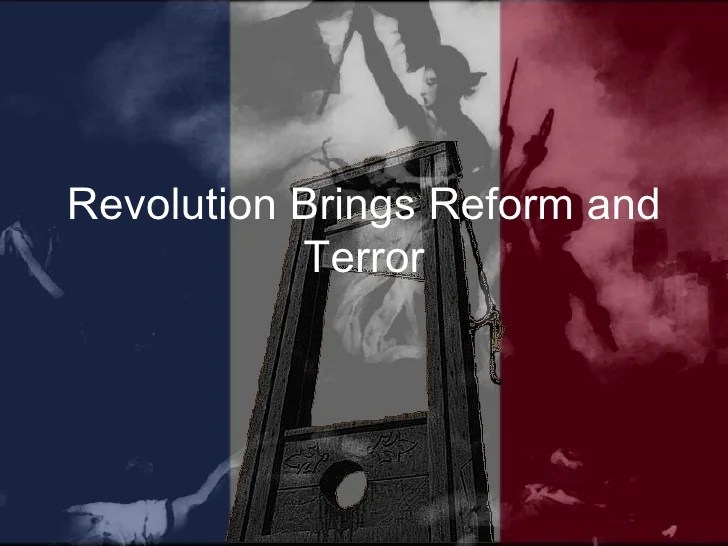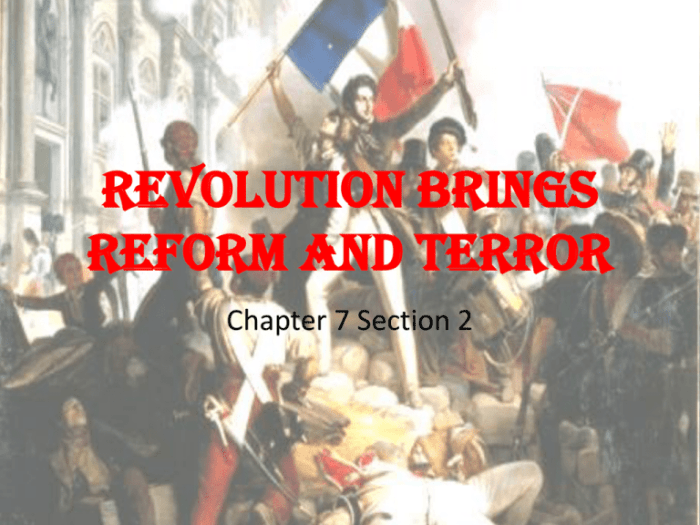Revolution brings reform and terror, an intriguing paradox that has shaped the course of human history. This narrative delves into the multifaceted nature of revolutions, exploring their transformative power to ignite societal change while simultaneously acknowledging the potential for violence and upheaval that often accompanies them.
Throughout history, revolutions have served as catalysts for profound reforms, dismantling oppressive regimes and fostering greater equality. From the French Revolution to the American Revolution, these pivotal events have left an indelible mark on the world, reshaping political landscapes and social structures.
Revolution as a Catalyst for Reform

Revolutions serve as pivotal moments in history, triggering transformative changes in societal structures and institutions. They ignite the flames of rebellion against oppressive systems, paving the way for the establishment of more just and equitable societies.Revolutions act as catalysts for the abolition of oppressive regimes, replacing them with governments that prioritize the rights and freedoms of citizens.
For instance, the French Revolution witnessed the overthrow of the absolute monarchy, leading to the establishment of a republic founded on the principles of liberty, equality, and fraternity. Similarly, the American Revolution culminated in the formation of a new nation based on democratic ideals, severing ties with British colonial rule.
The Dual Nature of Revolution

Revolutions are complex and multifaceted phenomena that often involve a paradoxical mix of transformative reforms and violent upheavals. This dual nature stems from the inherent tension between the idealistic aspirations of revolutionaries and the practical challenges of implementing radical change in a society.
On the one hand, revolutions are driven by a desire for a better future, a belief that the existing order is unjust or oppressive and must be overthrown. This idealism often leads to a commitment to sweeping reforms, such as the establishment of democratic institutions, the redistribution of wealth, or the recognition of fundamental rights.
In the pursuit of these goals, revolutionaries may resort to violent means, such as armed insurrection or mass protests, in order to overthrow the existing regime and establish a new order.
On the other hand, revolutions can also be accompanied by significant violence and terror. The overthrow of an established order often creates a power vacuum, which can be exploited by radical elements or opportunistic individuals. The breakdown of social norms and the suspension of legal protections can lead to widespread chaos and bloodshed.
Furthermore, the pursuit of revolutionary ideals can sometimes lead to unintended consequences, such as the establishment of authoritarian regimes or the perpetuation of violence and oppression.
Challenges Faced by Revolutionary Leaders
The dual nature of revolution poses significant challenges for revolutionary leaders. They must balance the need for radical change with the potential for chaos and bloodshed. They must also find ways to maintain the support of their followers while navigating the complex and often treacherous path to power.
One of the key challenges faced by revolutionary leaders is the need to maintain discipline and unity within their movement. The pursuit of revolutionary ideals can attract a diverse range of individuals, from idealistic reformers to radical extremists. Balancing the demands of these different groups can be difficult, and it is often a source of internal conflict and division.
Another challenge is the need to manage the expectations of the masses. Revolutions often generate high hopes and expectations for a better future. However, the reality of implementing radical change is often complex and fraught with difficulties. Revolutionary leaders must find ways to manage these expectations and prevent disillusionment and frustration from setting in.
The Impact of Revolution on Individuals and Society: Revolution Brings Reform And Terror
Revolutions are transformative events that profoundly impact individuals and societies. They often entail significant psychological, emotional, and physical upheaval for participants and bystanders alike.
Psychological and Emotional Impact
Revolutions can trigger a range of intense emotions, including fear, anxiety, anger, and hope. Participants may experience heightened levels of stress and trauma, leading to psychological distress and mental health challenges. The constant threat of violence, loss, and uncertainty can disrupt their sense of safety and well-being.
Physical Impact
Revolutions often involve armed conflict and violence, resulting in physical injuries, disabilities, and death. Participants may face exposure to hazardous environments, extreme conditions, and limited access to medical care. The physical toll of revolution can have long-lasting consequences for individuals and their families.
Social Impact
Revolutions can disrupt established social norms, traditions, and relationships. They challenge existing power structures and hierarchies, leading to social upheaval and conflict. Traditional values and beliefs may be questioned or abandoned, and new social identities and norms emerge.
Disruption of Social Order, Revolution brings reform and terror
Revolutions can lead to widespread social disorder and chaos. The collapse of existing institutions and structures can result in a breakdown of law and order, leading to increased crime, violence, and instability. The disruption of social order can have profound consequences for individuals and communities, undermining their sense of security and well-being.
Emergence of New Social Structures
Revolutions can also give rise to new social structures and organizations. They provide an opportunity for marginalized groups to challenge oppression and inequality, leading to the emergence of new political and social movements. These new structures can empower individuals and promote social change.
Historical Perspectives on Revolution and Reform

Revolutions have been a driving force of societal transformation throughout history, leading to both profound reforms and periods of terror and instability. By examining past revolutions, we can gain valuable insights into the strategies, tactics, and consequences of revolutionary movements.
Strategies and Tactics of Revolutionary Movements
Revolutionary movements have employed a wide range of strategies and tactics to achieve their goals. Some have relied on violent uprisings, while others have pursued more peaceful forms of resistance. The choice of strategy often depends on the political, social, and economic conditions of the time.
- Violent Revolutions:These involve the use of armed force to overthrow an existing government. Examples include the French Revolution and the Russian Revolution.
- Nonviolent Revolutions:These seek to bring about change through peaceful means, such as protests, strikes, and civil disobedience. Examples include the American Revolution and the Indian independence movement.
- Gradual Reform:Some revolutions occur through a more gradual process of reform, where changes are made over a longer period of time. Examples include the British Industrial Revolution and the Meiji Restoration in Japan.
Lessons Learned from Past Revolutions
The study of past revolutions offers valuable lessons for contemporary struggles for change. These lessons include:
- The importance of clear goals:Successful revolutions have clear and achievable goals that unite their supporters.
- The need for organization and leadership:Effective revolutionary movements are well-organized and have strong leadership.
- The potential for unintended consequences:Revolutions can lead to both positive and negative outcomes, and it is important to consider the potential consequences before taking action.
Contemporary Applications of Revolutionary Principles
Contemporary social and political movements continue to draw inspiration from revolutionary principles, employing nonviolent resistance, civil disobedience, and other forms of activism. These tactics, inspired by historical revolutions, aim to bring about change without resorting to violence.
Nonviolent Resistance
Nonviolent resistance, a powerful tool for social change, involves employing nonviolent tactics such as boycotts, sit-ins, and civil disobedience to challenge oppressive systems. Inspired by the teachings of Mahatma Gandhi and Martin Luther King Jr., nonviolent resistance has been successfully used in movements such as the Indian independence movement and the American civil rights movement.
Civil Disobedience
Civil disobedience involves intentionally violating laws or regulations as a form of protest. This tactic aims to draw attention to unjust laws or policies and provoke a response from authorities. Historically, civil disobedience has been used by figures such as Henry David Thoreau and Rosa Parks to challenge slavery and promote social equality.
Potential and Limitations of Revolutions
While revolutions can be powerful catalysts for change, they also come with potential limitations. Revolutions can be violent and destabilizing, leading to unintended consequences and setbacks. Additionally, the outcomes of revolutions are not always predictable, and there is a risk that the new regime may be as oppressive as the previous one.Despite
these limitations, revolutions can still be effective in addressing modern challenges. The Arab Spring uprisings, for example, demonstrated the potential of social media and technology in mobilizing citizens and challenging authoritarian regimes. Revolutions can also raise awareness of important issues and inspire broader social and political change.
Essential FAQs
What are the key factors that contribute to the success or failure of a revolution?
The success or failure of a revolution hinges on a multitude of factors, including the level of popular support, the effectiveness of leadership, the availability of resources, and the response of the existing regime.
How can revolutions be prevented from descending into violence and terror?
Preventing revolutions from spiraling into violence requires addressing underlying grievances, promoting dialogue and compromise, and ensuring a peaceful transition of power.
What are the long-term consequences of revolutions?
Revolutions can have profound and lasting consequences, reshaping political systems, social structures, and cultural norms. They can lead to greater freedom, equality, and prosperity, but also to instability, conflict, and repression.